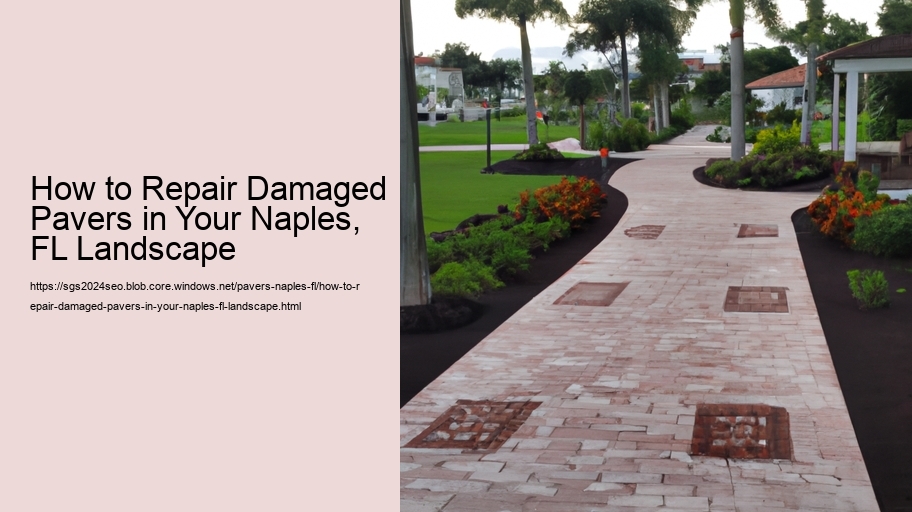Title: How to Repair Damaged Pavers in Your Naples, FL Landscape
How to Choose the Best Pavers for Your Naples, FL Home .
Introduction
Nestled along the Gulf of Mexico, Naples, Florida, boasts stunning landscapes and picturesque views that homeowners strive to enhance with beautiful outdoor spaces. Pavers are a popular choice for creating patios, walkways, and driveways in Naples, thanks to their durability and aesthetic appeal. However, over time, these pavers can become damaged due to various factors such as weather, wear and tear, or improper installation. Repairing damaged pavers is essential to maintaining the beauty and functionality of your landscape. In this essay, we will explore the steps to repair damaged pavers effectively, ensuring your outdoor space remains as inviting as ever.
Understanding the Causes of Damage
Before diving into the repair process, it is crucial to understand the common causes of paver damage. In Naples, the subtropical climate-with its high humidity, heavy rains, and occasional hurricanes-can significantly impact the condition of your pavers. Water can seep into the joints, causing the base to erode or shift, leading to uneven surfaces. Additionally, the roots of nearby trees or plants can push pavers out of place. Regular foot or vehicle traffic can also contribute to wear and tear. Identifying the cause of the damage will allow you to address the issue more effectively during the repair process.
Gathering the Necessary Tools and Materials
To repair damaged pavers, you will need specific tools and materials. These include a rubber mallet, a flathead screwdriver or pry bar, a level, a trowel, sand, gravel, a broom, and replacement pavers if necessary. Having these tools on hand will make the repair process smoother and more efficient.
Step-by-Step Repair Process
Assess the Damage: Begin by inspecting the damaged area to determine the extent of the repairs needed. Check for loose, cracked, or sunken pavers. Take note of any underlying issues, such as drainage problems or root intrusion, that may need to be addressed.
Remove the Damaged Pavers: Use a flathead screwdriver or pry bar to carefully lift the damaged pavers from the ground. Be gentle to avoid causing further damage to adjacent pavers. If the pavers are cracked but not loose, you may be able to repair them in place by filling cracks with a suitable sealant.
Prepare the Base: Once the damaged pavers are removed, inspect the base layer for any issues. If the base is uneven or eroded, remove the old sand or gravel and replace it with fresh material. Ensure the new base is level and compact it firmly to provide a stable foundation for the pavers.
Install Replacement Pavers: Place the new or repaired pavers into the prepared area, ensuring they are level with the surrounding pavers. Use a rubber mallet to gently tap them into place. If necessary, cut pavers to fit the space using a masonry saw.
Fill Joints with Sand: Once the pavers are securely in place, spread sand over the entire area. Use a broom to sweep the sand into the joints between the pavers. This will help lock them in place and prevent shifting.
Compact and Finish: Finally, use a plate compactor or a hand tamper to compact the pavers and sand, ensuring a firm and even surface. Sweep away any excess sand, and your repaired area should blend seamlessly with the rest of your landscape.
Preventive Measures
To prolong the life of your pavers and minimize future damage, consider implementing preventive measures. Regularly inspect your pavers for signs of wear and address minor issues promptly. Ensure proper drainage around your paved areas to prevent water accumulation. Additionally, trimming nearby vegetation can prevent root intrusion, and applying a sealant can protect the surface of the pavers from stains and weathering.
Conclusion
Repairing damaged pavers in your Naples, FL, landscape may seem daunting, but with the right tools, materials, and techniques, it can be a manageable DIY project. By understanding the causes of damage and following a systematic repair process, you can restore your outdoor space to its former glory. Not only will this enhance the beauty of your landscape, but it will also ensure a safe and functional environment for you and your family to enjoy for years to come.

